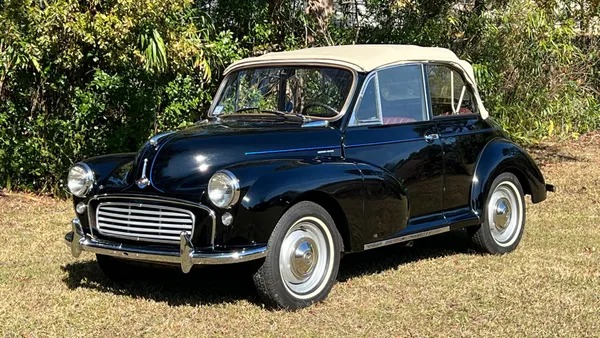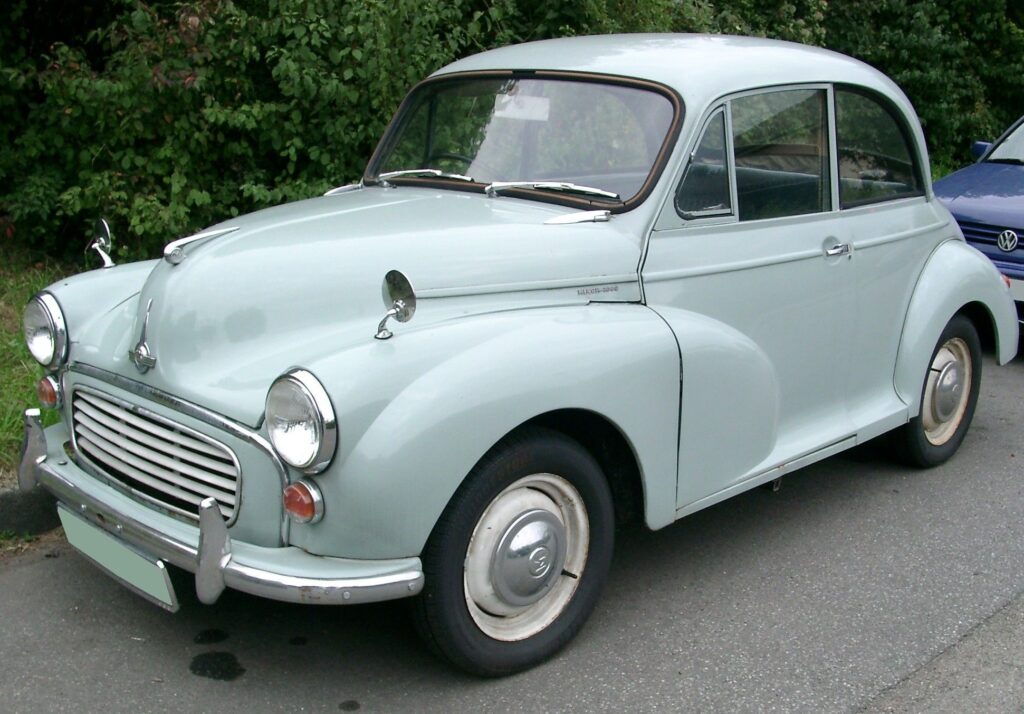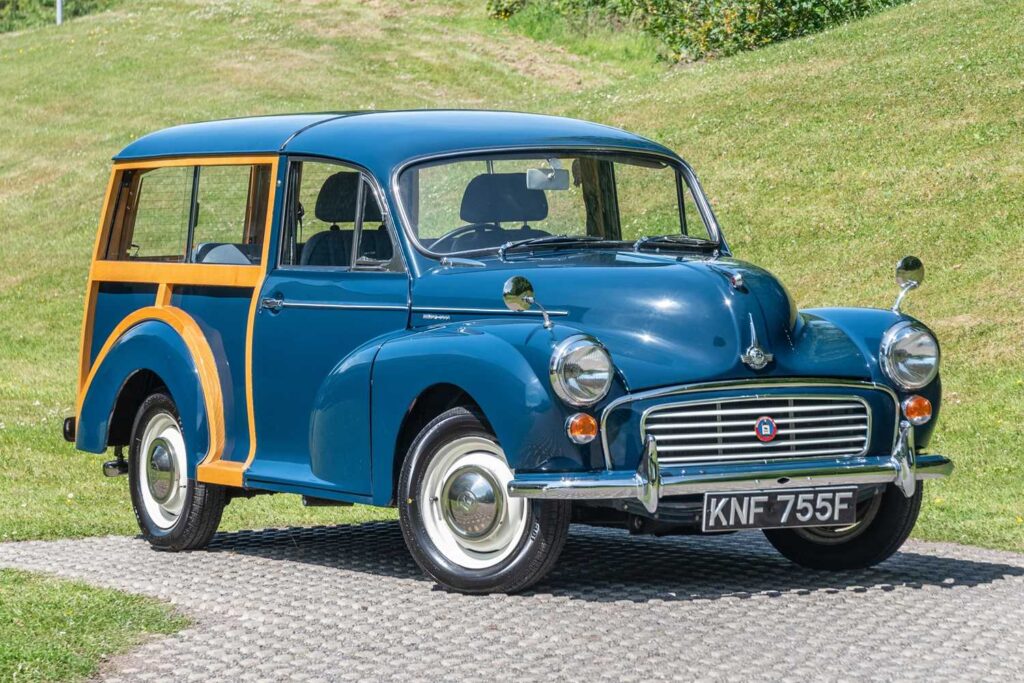
Morris Minor: A Symbol of British Automotive History
The Morris Minor holds a significant place in automotive history. Launched in 1948, it was one of the most beloved British cars of the mid-20th century and played a key role in shaping the post-war car industry. Known for its charming design, affordability, and practicality, the Morris Minor became a symbol of everyday British motoring. But what made this vehicle so special, and how did it evolve over time? In this article, we will take a closer look at the history of the Morris Minor, its various models and transitions over the years, and explore the car’s value fluctuations.
What is The History of the Morris Minor
The Morris Minor’s journey began in 1948, when it was first introduced by the Morris Motor Company. Designed by Alec Issigonis, the same man responsible for the Mini, the Morris Minor was created to fill a gap in the market for a small, affordable family car. The car’s innovative design and practicality made it an instant success in post-war Britain, where the need for affordable transport was at an all-time high.
The Morris Minor was available in two styles initially: a two-door saloon and a four-door saloon. It was powered by a 918cc engine, which offered just enough power for its compact size while being economical on fuel. Over the years, the Morris Minor underwent several updates, both in terms of design and engineering, but it always maintained its reputation for reliability and low running costs.
By the 1950s, the Morris Minor had become one of the most popular cars in Britain, and it was exported to countries around the world, including Australia, New Zealand, and even the United States. As the car continued to evolve, new variants were introduced, including the Morris Minor 1000, which replaced earlier models with a more powerful engine and updated design.
The Morris Minor remained in production until 1971, with over 1.3 million units produced. Despite its discontinuation, the car’s legacy has endured, and it remains a beloved classic among car enthusiasts today.
Evolution Overview of the Morris Minor

| Model Name | Year of Production | Engine | Price Range (Current Market) | Notes |
| Morris Minor 1000 Saloon | 1956 – 1971 | 948cc / 1098cc | £4,000 – £8,000 | Most popular model, more powerful engine, upgraded interior and features. |
| Morris Minor 1000 Traveller | 1953 – 1971 | 948cc / 1098cc | £6,000 – £12,000 | Station wagon version with wooden side panels. Iconic design. |
| Morris Minor 2-Door Saloon | 1948 – 1953 | 918cc | £2,000 – £4,500 | Early model, basic features, more original design. |
| Morris Minor 4-Door Saloon | 1950 – 1971 | 948cc / 1098cc | £4,500 – £9,000 | Additional rear doors, more space for family use. |
| Morris Minor Series II | 1952 – 1956 | 803cc | £2,500 – £5,000 | Updated one version, higher performance than the first series. |
| Morris Minor Lowlight | 1948 – 1953 | 918cc | £4,000 – £7,500 | Unique early design with different headlights, highly collectible. |
| Morris Minor Auto (Automatic Transmission) | 1960s – 1970s | 948cc / 1098cc | £5,500 – £10,000 | Automatic transmission for easier driving. Less common than manual models. |
| Morris Minor Convertible | 1961 – 1971 | 948cc | £6,500 – £12,500 | Open-top version, highly desirable for classic car lovers. |
| Morris Minor Van | 1952 – 1971 | 948cc / 1098cc | £3,500 – £7,500 | The commercial version is used for small business deliveries. |
| Morris Minor Pick-up | 1953 – 1971 | 948cc / 1098cc | £5,000 – £9,000 | Utility version, popular with collectors and farmers. |
Over the years, the Morris Minor underwent several key transitions that helped shape its identity and continued success. These changes were not only mechanical but also design-focused, which ensured that the Morris Minor kept up with the times.
What are The Models of Morris Minor
The Morris Minor came in various models over the years, with each new release incorporating design and technological improvements. The initial versions of the car had a more rudimentary design, with simple lines and basic features. However, when the Morris Minor 1000 was introduced in the 1950s, this auto gained a more modern and stylish look.
1. Morris Minor 1000 (1956–1971)
The Morris Minor 1000 is undoubtedly the most iconic model of the Morris Minor series. Launched in 1956, it introduced significant updates, including a more powerful 948cc engine, later upgraded to 1098cc. This version offered better performance, handling, and comfort compared to earlier models, making it a favourite among families and small businesses. The 1000 was available in various body styles, including the 2-door saloon, 4-door saloon, and the Morris Minor Traveller, which featured wooden side panels. The Traveller variant offered extra cargo space, making it ideal for transporting goods or families. Not only did it have updated features such as improved suspension and a more refined interior, but its classic design also made it an enduring symbol of British motoring. The Morris Minor 1000 was in production for 15 years, making it the most successful version in terms of sales and longevity.
2. Morris Minor 2-Door Saloon (1948–1953)
The original Morris Minor 2-Door Saloon was the car that started it all. First released in 1948, it featured a small 918cc engine, making it an affordable choice for post-war Britain. This early version of the Morris Minor was simple and functional, with a charming design characterised by rounded body lines and a compact footprint. The two-door configuration offered easy access to the cabin, and the car’s affordability and reliability made it popular among families. Although the features were basic by today’s standards, the model introduced an important concept in affordable motoring. The Morris Minor 2-Door Saloon was also the first model to showcase the car’s iconic “Morris Minor” branding, setting the tone for future models.
3. Morris Minor 4-Door Saloon (1950–1971)
Released in 1950, the Morris Minor 4-Door Saloon offered a more family-friendly alternative to the 2-door saloon. It shared much of the same styling and mechanical features but added extra practicality with its four-door layout, which made it easier for families to access the rear seats. The 948cc engine was introduced with this model, offering improved power and performance over the earlier 918cc version. It also benefited from a more refined interior, providing better comfort for passengers on longer trips. Throughout its production run, the 4-door saloon remained a popular choice due to its spaciousness, affordability, and ease of use, particularly for families or those requiring a more versatile vehicle.
4. Morris Minor Series II (1952–1956)
The Morris Minor Series II showed the first prominent update to the original Morris Minor car. Produced from 1952 to 1956, this model featured a slightly larger 803cc engine compared to its predecessor, improving its performance. It also introduced some crucial mechanical upgrades, including a more modern suspension system and better handling, making it a smoother and more comfortable car to drive. Visually, the Series II kept the traditional rounded body shape but included refinements that helped it keep pace with modern design trends. It was the perfect blend of functionality and style, setting the stage for the larger, more powerful Morris Minor 1000 that would follow.
5. Morris Minor Traveller (1953–1971)
The Morris Minor Traveller is one of the most liked autos of the Morris Minor series. First introduced in 1953, this station waggon version stood out with its signature wooden side panels. These panels not only gave the car its distinctive look but also helped keep the vehicle lightweight and easy to handle. The Traveller was designed with practicality in mind, offering ample cargo space for goods and larger families. It retained the 948cc engine from the Morris Minor 1000, ensuring that it remained efficient yet capable for everyday use. The Morris Minor Traveller became especially popular with small businesses, delivery services, and families who needed a car with extra room. It remains a sought-after collector’s item today due to its unique design and utility.
6. Morris Minor Convertible (1961–1971)
The Morris Minor Convertible, produced between 1961 and 1971, added a touch of glamour to the line-up with its open-top design. Featuring the same 948cc engine as the Morris Minor 1000, the Convertible offered the same reliability and performance but with the added fun of an open-air driving experience. This model was aimed at those who wanted a more stylish version of the traditional saloon, offering an enjoyable ride for leisurely drives. The convertible had all the features of the Morris Minor but had appeal with its retractable roof and sporty aesthetic. Due to its rarity and unique design, the Morris Minor Convertible is now considered a prized collector’s item.
7. Morris Minor Van and Pick-up (1952–1971)
The Morris Minor Van and Pickup versions were introduced as light commercial vehicles, providing businesses with a cost-effective solution for transporting goods. Both models were equipped with the same 948cc engine, making them ideal for small deliveries or tradesmen. The Morris Minor Van had an enclosed rear section, providing ample space for carrying goods, while the pickup featured an open truck bed. These commercial variants were highly popular during their production years and continue to be valued by collectors today, particularly due to their classic design and practicality. While the van and pickup models weren’t as glamorous as the Traveller or Convertible, their utility made them indispensable for many businesses at the time.
Each model of the Morris Minor brought something unique to the table, whether it was the simplicity and affordability of the early saloon versions, the utility of the van and pickup, or the style of the convertible and Traveller. Over time, these vehicles have become cherished classics due to their reliable performance and timeless design.
Which One is The Famous Model of Morris Minor

The Morris Minor 1000 is undoubtedly the most famous and widely sold model of the Morris Minor series. Produced between 1956 and 1971, it became the symbol of affordable, reliable British motoring. The model’s success was largely due to its practicality, with a larger 948cc engine that offered better performance compared to earlier models. The Morris Minor 1000’s simple yet durable design, coupled with its low running costs, made it a favourite among families and businesses alike, solidifying its place in automotive history.
As of August 2025, the market value of a Morris Minor 1000 varies based on factors such as condition, originality, and specific model variant. For instance, a 1960 Morris Minor 1000 Traveller with a 1275cc engine and 12,625 miles was listed at $18,995. Similarly, a 1961 Morris Minor 1000 Convertible in good condition was sold for $18,150 at auction at Street Side Classics and Gooding & Co.
In the UK, prices for a Morris Minor 1000 can range from approximately £4,000 for models in need of restoration to over £14,000 for well-maintained or restored examples. Notably, a 1968 Morris Minor 1000 Convertible was recently sold for £15,469 at auction at Classic.com.
Why is the Morris Minor Worth Having
The Morris Minor is an iconic British classic that offers a unique blend of vintage charm, practicality, and history. With its affordable price point, especially for older models, the Morris Minor makes a fantastic entry-level classic car for those interested in vintage motoring. The car’s small size, simple mechanics, and fuel efficiency make it easy to maintain and a joy to drive, especially for those who appreciate the nostalgic feel of a classic ride. Furthermore, its unique look—especially the Morris Minor 1000 with its updated engine—adds to its allure as a standout car in any collection.
As for celebrity ownership, Daniel Radcliffe, known for playing Harry Potter in the famous film franchise, has been seen driving a Morris Minor. The actor’s ownership of the car reflects his appreciation for quirky, vintage items and highlights the enduring appeal of this charming classic. If you own a Morris Minor, you can join the list of famous people who value the vehicle’s fun factor as well as its historical significance.
What is The Current Price of Morris Minor
| Model Type | Price Range (GBP) | Notes |
| Morris Minor 1000 Saloon | £3,995 – £14,500 | Most common model; prices vary based on condition and originality. |
| Morris Minor 1000 Traveller | £8,750 – £29,985 | The estate version; higher prices for well-maintained or restored units. |
| Morris Minor Convertible | £10,575 – £21,500 | Open-top model; prices influenced by restoration quality and rarity. |
| Morris Minor Series II | £1,100 – £9,750 | Earlier model; lower prices for unrestored examples. |
| Morris Minor Million (1961) | £8,064 – £15,318 | Special edition; higher value for well-preserved examples. |
| Morris Minor 1000 Auto | £5,500 – £10,000 | Automatic transmission variant; less common, affecting price. |
| Morris Minor Van/Pickup | £3,500 – £9,000 | Commercial variants; prices depend on condition and restoration. |
Note: Prices are approximate and can vary based on specific market conditions and individual vehicle characteristics.
What Is The Market Trends for Morris Minor
Recent data indicates that the average sale price for a Morris Minor 1000 is around $16,643, with the highest recorded sale at $42,000 for a 1959 Morris Minor 1000 Traveller. Conversely, some models have sold for as low as $1,803, particularly those in need of restoration; you can visit Classic.com.
In the UK, the market has seen a slight decline in prices for certain classic cars, including the Morris Minor 1000 Convertible, which has an average value of approximately £10,575, up from £10,000 in previous years; please visit The Sun.
What Factors Influence the Price of Morris Minor
- Condition: Well-maintained or restored vehicles command higher prices.
- Originality: Cars retaining original parts and features are more valuable.
- Model Rarity: Limited edition models or those with unique features tend to be priced higher.
- Documentation: Complete service history and ownership records can enhance value.
What are The Tips to Buy Morris Minor
- Inspect Thoroughly: Check for rust, especially in the chassis and floor pans.
- Verify Authenticity: Ensure the vehicle’s originality to maintain value.
- Consider Restoration Needs: Factor in potential restoration costs when evaluating price.
- Seek Expert Advice: Consult classic car enthusiasts or clubs for guidance.
How to Import or Export Morris Minor
To import or export a Morris Minor, we can provide you all the services by managing every step. First of all, we will provide you an accurate quote for shipping. We will help you with a guide on Morris Minor origin, destination, and preferred shipping method, whether it’s container shipping or roll-on/roll-off (RoRo). Our company will be assisting you with a complete guide on the required paperwork, including vehicle registration, title, and customs clearance documents, ensuring full compliance with import and export regulations.
Our team collaborates directly with customs to manage taxes, duties, and all legal requirements involved in importing or exporting vehicles, ensuring you don’t have to deal with complex procedures. With our expertise and fully educated staff, Ship Cars Limited makes your car shipping smooth, hassle-free, and dependable.
If you are an auto lovery you may also want to read Firebird Auto Legendary Journey Through Its Generations.
Conclusion
The Morris Minor is more than just a car; it’s a symbol of British automotive history. From its humble beginnings as an affordable family car to its status today as a beloved classic, the Morris Minor’s story is one of innovation, reliability, and charm. Whether you’re a first-time buyer, a seasoned collector, or simply someone who appreciates classic cars, the Morris Minor offers something special.
Whether you’re looking to buy a Morris Minor, find replacement parts, or learn more about its evolution, this iconic car’s legacy continues to captivate enthusiasts worldwide. If you are interested in knowing every bit of this car, you may like to visit Wiki.







